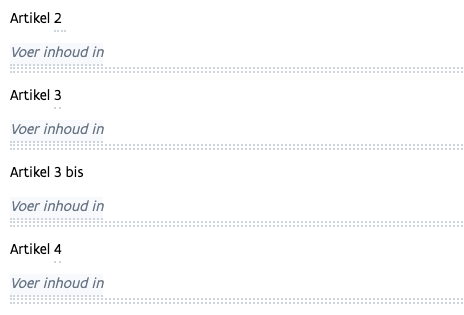lay-out & titles within decisions "Reglementen" / Regulatory Statements
Hierarchy of a document and the use of "titles"
Grouping of articles within a regulatory statement:
A reglement / regulatory statement can contain tens of articles. It is recommended to group them. generally articles are grouped in "chapters" (hoofdstukken). Chapters can have "afdeling" en "onderafdeling" as a sub)
Chapters can be ordered in titles, books and parts. Each one can contain articles.
In brief:
Deel (part)
Boek (book)
Titel (title)
Hoofdstuk (chapter)
Afdeling
Onderafdeling
When grouping articles you start with the use of chapters. If this is not sufficient, you can go down: afdeling, subsequently onderafdeling. If this still is not sufficient, a title, subsequently a book, subsequently a part (deel) are to be used.
All these "text grouping weapons" have a name (opschrift).
article: the use of article descriptions / titles (artikelopschrift) is common and should be enabled.
Though the use of (artikelopschrift) is not recommended by legal experts due to the maintenance challenge. Keeping the title short is a challenge. Furthermore the title should keep track of all the changes that are made (de vlag dient de lading te dekken).
General rule is one legal rule per article, one thought per sentence, except if the coherence asks otherwise.
Articles are numbered 1,2,3 etc. Sometimes a change can evoke an article number like "article 3 bis" in order not needing to renumber all articles. See image below:
paragraph - partition of an article, the paragraph sign is used.
If more than 3 "lid / leden" exist, a paragraph can be used.
Important is only to use paragraphs if absolutely mandatory to contain several hypothesises or alternatives in one article.
Coordinated version extra's:
Coordinated versions are managed by the administrave bodies of the local government (of several departments depending on the context of the regulation).
Communicated via the local government's website: some, depending on the content. (e.g. RPR and tax rules: yes)
Communicated in draft - mentioning it's a draft (not ratified), e.g. "officieuze coordinatie van het algemeen bouwreglement"). It should be mentioned that "alleen de door de bevoegde raden vastgestelde en bekendgemaakte teksten zijn bindend").
Added to the decision, this pro-activity supports mandatees before voting the changes, to see the impact the changes have on the global regulatory statement.
Visualise the history of the text : Important is to be able to visualise the history of the provision (bepaling). 2 ways that are accepted:
by Footnotes: use of footnotes is common in order to communicate changes.
A common alternative is to "strike through" and put new text in bold.
Temporarily provisions (bepalingen) are not part of the coordinated version once they are due, and could be left out once they are due.
Grouping of articles are in reflect of the content/meaning. Next structure is "strongly proposed" (aanbevolen).
omschrijving van het toepassingsgebied of de doelstelling
definities
inhoudelijke regels (verplichtingen, toepassingsvoorwaarden, administratieve procedure,...)waarbij een onderscheid wordt gemaakt tussen algemene bepalingen en bijzondere bepalingen
toezicht en sancties
slotbepalingen (wijzigingsbepalingen, opheffingsbepalingen, overgangsregeling, inwerkingtredingsbepaling, buitenwerkingtredingsbepaling)
Last updated
